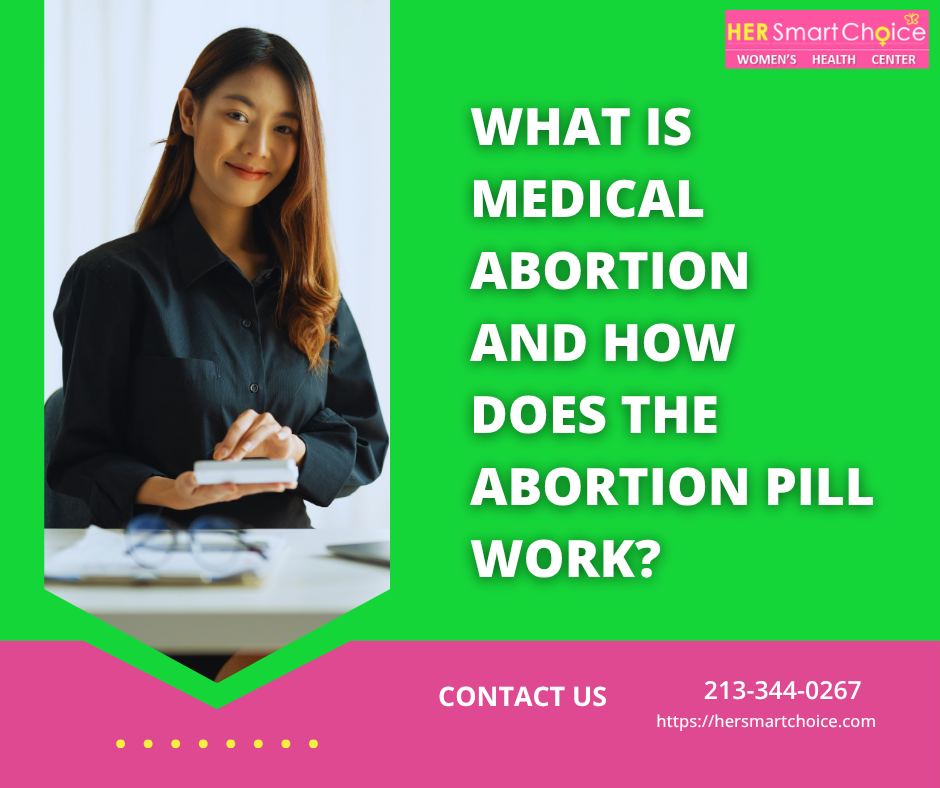Comprehensive Guide to Women’s Health Clinic for Abortion Services and Support
Approximately one in four women in the U.S. will seek abortion care in their lifetime, yet many face uncertainty about procedures, costs, and legal rights. Navigating a women’s health clinic for abortion services and support can feel overwhelming, and this guide addresses common concerns head-on. We will explore:
- Types of abortion procedures and how they work
- Pregnancy consultation and counseling services
- Cost breakdowns and financial assistance options
- State-specific laws and patient rights
- After-abortion care and recovery timelines
- Telehealth abortion eligibility and limitations
- Locating trusted abortion clinics and comprehensive health centers
By mapping each step—from medical abortion pills to post-procedure contraception—you’ll gain clarity, confidence, and access to compassionate women’s health centers at Her Smart Choice.
What Types of Abortion Procedures Are Offered at Women’s Health Clinics?
Women’s health clinics typically provide two primary abortion procedure categories: medical abortion, which uses approved drugs to terminate early pregnancy, and surgical abortion, an in-clinic procedure suited for a range of gestational ages that offers immediate completion and high effectiveness. Both categories are performed by licensed medical professionals in a clinical setting that prioritizes patient safety and privacy.
By understanding these core options, you can choose the method that best fits your health needs and personal circumstances, leading into detailed explanations of each approach.
What Is Medical Abortion and How Does the Abortion Pill Work?

Medical abortion combines two drugs—mifepristone and misoprostol—to end a pregnancy up to 10 weeks gestation by blocking progesterone and inducing uterine contractions for tissue expulsion, offering a non-surgical, privacy-focused option at Her Smart Choice.
Before starting, a clinician confirms gestational age via ultrasound and reviews medical history. First, mifepristone disrupts the uterine lining; 24–48 hours later, misoprostol triggers cramping and bleeding to complete the process.
- Private at-home administration
- No anesthesia required
- Over 95% effectiveness within the first 10 weeks
Patients typically experience cramping and bleeding similar to a heavy menstrual period. Aftercare instructions include rest, hydration, and follow-up contact with the clinic.
What Surgical Abortion Options Are Available and How Are They Performed?
Surgical abortion encompasses vacuum aspiration and dilation and evacuation (D&E) procedures performed in-clinic under local or general anesthesia, providing immediate completion and minimal follow-up.
Vacuum aspiration, used up to 14 weeks, employs gentle suction to remove pregnancy tissue. D&E, offered after 14 weeks, combines dilation of the cervix with surgical instruments to evacuate the uterus.
- In-clinic appointment
- Short procedure time (5–15 minutes)
- Rapid resolution of pregnancy tissue
After surgical abortion, patients rest for 1–2 hours in recovery before discharge with pain management and follow-up guidelines.
How Does Gestational Age Affect Abortion Procedure Choices?
Gestational age determines which abortion method is safest and most effective. Early pregnancy (up to 10 weeks) typically allows medical abortion; between 10 and 14 weeks, both medical and vacuum aspiration options are available; after 14 weeks, D&E becomes the preferred surgical approach.
| Entity | Attribute | Value |
|---|---|---|
| Early Pregnancy | Medical Option | Abortion pill (mifepristone/misoprostol) |
| Mid Pregnancy | Combined Options | Vacuum aspiration or medical abortion |
| Later Pregnancy | Surgical Option | Dilation and evacuation |
Abortion Procedures and Gestational Age
The choice of abortion procedure is heavily influenced by gestational age, with medical abortion typically available up to 10 weeks, vacuum aspiration up to 14 weeks, and dilation and evacuation (D&E) preferred after 14 weeks. This framework ensures the safest and most effective approach for each patient.
American College of Obstetricians and Gynecologists, Practice Bulletin No. 143: Medical Management of Abortion (2014)
This bulletin provides guidelines on the different abortion methods and their relation to gestational age, which directly supports the article’s explanation of procedure choices.
What Are the Benefits and Risks of Medical vs. Surgical Abortion?
Medical and surgical abortion each deliver high effectiveness with distinct profiles in recovery time, privacy, and side effects.
| Entity | Attribute | Medical Abortion | Surgical Abortion |
|---|---|---|---|
| Effectiveness | Success Rate | 95–98% within 10 weeks | >99% in first trimester |
| Recovery Time | Duration | 1–2 days of bleeding | 1–3 days of cramping |
| Side Effects | Common Symptoms | Nausea, heavy bleeding, cramping | Spotting, cramping, mild pain |
| Setting | Location | At-home follow-up | In-clinic procedure |
| Privacy | Discretion | High (at home) | Moderate (clinic visit) |
Both approaches are safe under clinic supervision; individual health factors and personal preferences guide method selection, leading into how counseling supports that decision.
How Can Pregnancy Consultation and Counseling Support Women Facing Unplanned Pregnancies?
Pregnancy consultation and non-directive counseling combine medical information with emotional support to help individuals facing unplanned pregnancies make informed choices about abortion, adoption, or parenting. By offering unbiased facts, compassionate listening, and resource referrals, clinics empower clients to decide with clarity and confidence.
What Is Pregnancy Options Counseling and How Does It Help Decision-Making?
Pregnancy options counseling provides unbiased information on all pregnancy outcomes—continuation, adoption, or abortion—while offering emotional reassurance and decision-making tools. Counselors clarify medical facts, legal rights, and logistical considerations, ensuring each individual understands benefits and implications of every path.
Clients leave with a personalized plan that reflects their values and circumstances, preparing them for a pre-abortion consultation or alternative support services.
What Alternatives to Abortion Are Discussed During Counseling?
Counselors discuss parenting resources, adoption agencies, and supportive community programs alongside abortion information. They map out prenatal care options, financial assistance for single parents, and local versus open adoption models.
List of Alternatives Explored:
- Parenting Support Programs that connect to childcare and health services.
- Open and Closed Adoption Plans tailored to birth parent preferences.
- Kinship Care Referrals when family members assume caregiving roles.
These alternatives complement abortion discussions and transition seamlessly into pre-procedure consultations.
What Happens During a Pre-Abortion Consultation at a Women’s Health Clinic?
A pre-abortion consultation includes a confidential health assessment, ultrasound to confirm gestational age, review of medical history, and discussion of chosen procedure. Clinicians explain step-by-step processes, potential side effects, and aftercare protocols, ensuring informed consent.
Patients receive clear instructions on fasting (for surgical care), medication timing (for medical abortion), and contact information for post-procedure support. This thorough visit bridges counseling to safe clinical treatment.
How Much Does Abortion Cost and What Financial Assistance Is Available?
Abortion costs vary by procedure type, gestational age, and location, typically ranging from $580 for medical abortion to over $2,000 for later surgical procedures. Clinics often offer sliding-scale fees, discounts, or bundled packages for complete care, and many refer to nonprofit abortion funds for additional support.
Understanding these cost factors helps patients plan and access financial aid, which we explore in detail below.
What Are the Typical Costs for Medical and Surgical Abortions by State?
Costs fluctuate based on provider rates and state regulations. The following table illustrates average ranges:
| Entity | Attribute | Medical Abortion Cost | Surgical Abortion Cost |
|---|---|---|---|
| State A | Early (<10 weeks) | $580–$700 | $300–$450 |
| State B | Mid (10–14 weeks) | N/A | $500–$900 |
| State C | Later (>14 weeks) | N/A | $1,200–$2,100 |
Clinics may include follow-up visits and counseling in bundled fees. These figures guide budgeting and highlight interstate variations in access.
How Does Insurance Coverage Affect Abortion Costs?
Insurance coverage depends on state Medicaid policies and private plan terms. In some states, Medicaid covers abortion for qualifying low-income individuals; private insurance may cover medication and procedure costs partially or fully.
Key Coverage Factors:
- Medicaid Expansion in certain states includes abortion care.
- Employer Health Plans vary by plan language and state mandates.
- Sliding-Scale Discounts offered when insurance is unavailable.
Patients work with clinic financial counselors to verify benefits, minimizing out-of-pocket expenses.
What Financial Assistance Programs and Abortion Funds Can Help?
Clinics often partner with local and national abortion funds to provide grants, travel stipends, and lodging assistance for those in restrictive states.
Financial Assistance for Abortion
Abortion costs vary widely, and financial assistance is often available through various programs. Clinics frequently partner with local and national abortion funds to provide grants, travel stipends, and lodging assistance, ensuring access to care regardless of financial constraints.
Guttmacher Institute, State Abortion Policies in 2024 (2024)
This resource provides information on state-specific abortion policies, including financial assistance programs, which is relevant to the article’s discussion of costs and aid.
Major programs include:
- National Abortion Federation Fund offering partial grants
- Local Abortion Funds tailored to community needs
- Travel and Accommodation Grants for interstate care
These resources fill coverage gaps and ensure equitable access to reproductive health services.
What Are the Current Abortion Laws and Patient Rights by State?
Abortion laws differ widely across states, impacting gestational limits, waiting periods, and consent requirements. Understanding these legal frameworks helps patients plan timely access to care and safeguards their confidentiality and autonomy.
We’ll examine how state-specific regulations shape access, privacy protections, and travel considerations.
How Do State-Specific Abortion Laws Impact Access to Care?
Many states enforce gestational limits (6–24 weeks), mandatory waiting periods (24–72 hours), and parental consent for minors. Some states require in-person counseling or ultrasound viewing. These regulations influence where and when patients can schedule procedures.
Patients in restricted states may travel to neighboring states with fewer barriers, connecting legal context to telehealth and travel assistance discussed later.
What Legal Protections Exist for Patient Confidentiality and Rights?
Federal and state privacy laws protect medical records under HIPAA, ensuring patient confidentiality. Some states have additional statutes shielding minors and adults from disclosure to third parties. Clinics maintain strict privacy protocols and secure patient data, reinforcing trust in women’s health centers.
Understanding these protections empowers patients to exercise informed consent without fear of unauthorized disclosure.
Can Patients Travel Across States for Abortion Services?
Yes, interstate travel for abortion is legal; patients often seek care in states with fewer restrictions. Travel planning may involve coordinating clinic appointments, lodging, and financial assistance programs. Telehealth abortion services may also reduce travel needs for early-gestation care.
Logistical support enables timely access to safe abortion options despite legal disparities.
What Does After Abortion Care and Recovery Involve at Women’s Health Clinics?
After abortion, clinics provide follow-up assessments, pain management guidance, and emotional support to ensure complete physical and mental recovery. Post-procedure care promotes healing, monitors for complications, and transitions patients to ongoing reproductive health services.
This section outlines physical symptoms, emotional recovery, and future family planning.
What Physical Symptoms and Recovery Timeline Should Patients Expect?
Most patients experience bleeding and cramping for 1–2 weeks after medical abortion and up to a week after surgical procedures. Pain management includes over-the-counter analgesics, rest, and hydration. Follow-up visits confirm complete tissue expulsion and address any concerns.
Recovery milestones help patients plan rest and return to daily activities safely.
How Is Emotional Recovery Supported After an Abortion?
Clinics offer post-abortion counseling, support groups, and referrals to licensed therapists specializing in reproductive mental health. Emotional recovery may include relief, grief, or mixed feelings; ongoing support resources foster resilience and well-being.
Integrating emotional care completes the holistic approach initiated during pregnancy counseling.
What Family Planning and Contraception Options Are Available Post-Abortion?
After abortion, clinicians discuss contraception methods—oral pills, IUDs, implants, condoms—to prevent unintended pregnancy. Personalized family planning visits assess health factors and lifestyle preferences, creating a roadmap for future reproductive goals.
Contraceptive counseling seamlessly builds on aftercare and empowers long-term health management.
How Is Telehealth Expanding Access to Abortion Services?
Telehealth abortion delivers mifepristone and misoprostol by mail after an online assessment, expanding access for eligible patients in states without restrictive telemedicine bans. Virtual visits reduce travel burdens and maintain privacy.
Telehealth Abortion Services
Telehealth abortion services are expanding access by allowing remote consultations and medication delivery. Eligibility is determined by factors such as gestational age and state regulations, offering a convenient option for those who qualify.
National Abortion Federation, Telehealth Abortion (2024) Check out here
This resource provides information on telehealth abortion services, which is relevant to the article’s discussion of remote care models and patient eligibility.
What Is Telehealth Abortion and Who Is Eligible?
Telehealth abortion is a remote medical abortion service where patients complete intake forms, video consultations, and order medication by mail for pregnancies under 10 weeks. Eligibility criteria include age, gestational confirmation, and no contraindicating health conditions.
This model broadens reach, especially in rural or underserved areas, by connecting patients to certified telemedicine providers.
What Are the Benefits and Limitations of Telehealth Abortion Services?
Telehealth abortion offers privacy, convenience, and reduced travel costs while enabling remote prescription of abortion pills. Limitations include state-by-state legal restrictions, shipping delays, and lack of immediate in-person emergency care.
Benefits & Limitations Summary:
- Benefit: At-home privacy and comfort
- Benefit: Reduced logistical barriers
- Limitation: Not available in all states
- Limitation: Requires reliable mail service
Patients weigh these factors when choosing remote versus in-clinic care, linking telehealth to physical and legal access pathways.
Where Can Women Find Trusted Abortion Clinics and Women’s Health Centers Near Them?

Locating a safe, licensed abortion clinic involves verifying credentials, reading patient reviews, and using reputable directories. Comprehensive women’s health centers often provide abortion services alongside reproductive health care, STI testing, and well-woman exams.
This final section guides users to resources for finding responsible, confidential care.
How to Locate Safe and Confidential Abortion Clinics?
Search accredited platforms such as the National Abortion Federation directory or state health department listings to find licensed providers. Look for clinics with clear privacy policies, certified medical staff, and positive patient testimonials.
Key Search Criteria:
- Accreditation by medical boards
- Transparent Pricing and financial aid options
- Privacy Policies and HIPAA compliance
By prioritizing these factors, patients connect with credible clinics that meet health and confidentiality standards.
What Services Do Comprehensive Women’s Health Centers Provide Beyond Abortion?
Comprehensive centers integrate abortion care with preventive gynecology, contraception counseling, pregnancy testing, STI screening, and hormone therapy. This full-spectrum model ensures continuity of care from family planning through menopause support, reinforcing patient trust and long-term health.
Clients benefit from coordinated services under one roof, making it easier to address every aspect of reproductive and sexual health.
Seeking compassionate, expert abortion care starts with informed choices. Whether exploring medical abortion pills, surgical options, pregnancy counseling, or telehealth services, women’s health clinics like Her Smart Choice offer structured support at every stage. For personalized guidance, schedule a confidential consultation with our licensed providers and discover safe, comprehensive reproductive health care near you.
Frequently Asked Questions
During an abortion procedure, whether medical or surgical, patients can expect a supportive environment where their comfort and safety are prioritized. For medical abortions, the process involves taking prescribed medications at home, while surgical abortions are performed in a clinic setting. Patients will receive detailed instructions on what to expect, including potential side effects and aftercare. It’s essential to have a support system in place, as emotional responses can vary. Clinics typically provide follow-up care to ensure a smooth recovery.
Preparing for a pre-abortion consultation involves gathering relevant medical history, understanding your menstrual cycle, and being ready to discuss any concerns or questions you may have. It’s helpful to write down any medications you are currently taking and any previous surgeries or health issues. Being open and honest with the clinician will facilitate a thorough assessment and ensure you receive the best care tailored to your needs. Additionally, consider bringing a support person for emotional comfort.
After an abortion, emotional support is crucial for many individuals. Clinics often provide access to counseling services, support groups, and resources for mental health professionals specializing in reproductive health. These services can help address feelings of relief, grief, or confusion that may arise post-procedure. Engaging in open discussions about your feelings with trusted friends or family can also be beneficial. Remember, seeking help is a sign of strength, and many have found comfort in shared experiences.
Like any medical procedure, abortions carry some risks, though they are generally low when performed by qualified professionals. Common risks include infection, heavy bleeding, and incomplete abortion, which may require further medical intervention. It’s essential to discuss these risks with your healthcare provider during the consultation. They will provide information on how to minimize risks and what symptoms to watch for post-procedure. Understanding these factors can help you feel more prepared and informed about your choices.
If you experience complications after an abortion, such as severe pain, heavy bleeding, or fever, it is crucial to contact your healthcare provider immediately. They can assess your condition and provide necessary care. Most clinics have protocols in place for follow-up care, so don’t hesitate to reach out. Keeping a record of your symptoms can help the provider understand your situation better. Prompt action can ensure your health and safety are prioritized during recovery.
Accessing telehealth abortion services typically involves an online consultation with a licensed healthcare provider. During this appointment, you will discuss your medical history and confirm your eligibility based on gestational age and health conditions. If approved, the provider will prescribe the necessary medications, which can be mailed to your home. It’s essential to check if your state allows telehealth abortions, as regulations vary. This option can be particularly beneficial for those in remote areas or with limited access to clinics.
Conclusion
Accessing safe and compassionate abortion services is crucial for women navigating unplanned pregnancies, and understanding the available options empowers informed decision-making. From medical and surgical procedures to counseling and financial assistance, women’s health clinics like Her Smart Choice provide comprehensive support tailored to individual needs. We encourage you to explore your options and connect with trusted providers for personalized care. Take the next step towards your reproductive health by scheduling a confidential consultation today.








